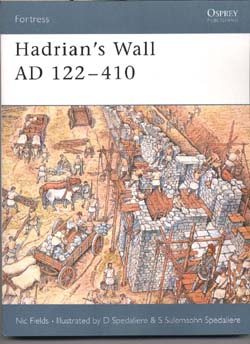 Hadrian's Wall AD 122-410 Hadrian's Wall AD 122-410
Fortress 2
By Nic Fields
Illustrated by D. Spedaliere & S. Sulemsohn Spedaliere
Osprey Publishing Ltd, 2003
ISBN 1-84176-430-2
64 Pages, Softbound Osprey’s second Fortress title deals with what is probably the best-known and certainly the largest Roman site in Britain, Hadrian’s Wall. The Wall follows well-established Roman principles of military engineering and a great deal remains to be seen today – anyone planning a visit would be well advised to read this book first in order to understand what they’re looking at. The Roman plan was not for an impregnable barrier. Although in some places it would be hard to assault, in others it would be a walkover – or at least a climb-over, though cavalry couldn’t cross it except at the gates. Its real function was as a trip-wire, with closely-spaced signal stations and lookouts to warn of any incursions and with forts of various sizes for rapid reaction forces. The Romans didn’t believe in huddling behind their walls, but went out into close combat to attack any force trying to cross the wall. This is shown very clearly in the forts, each with one or more gates through the Wall and some even projecting well beyond it with only a small part behind it. The approaches from England were covered by a ditch-and-banks system now called the vallum – there seems no evidence of what the Romans called it. Archaeologists and military students argue over its purpose, since it was not really a defensible structure, but the common consensus nowadays is that it marked the boundary of the “military zone” on the English side of the Wall. In places it runs very close to the Wall and its forts but in others so far away as to be beyond even stone-throwing artillery range. This book gives an excellent overview of the Wall and its forts from the organisation of its building to the final withdrawal of the Legions, including the life of the soldiers who manned it and the townships, which grew up near the forts. Photographs of some of the better-preserved or more interesting remains are supplemented by splendid colour plates. These reconstruct the layouts of forts of different sizes and show both the building of the Wall and a successful attack on one of the forts – to be precise, Rudchester, which is one of three known to have been destroyed by fire during a major incursion. There’s a lot here for visitors to the Wall and for modellers of the Roman army. Recommended! | 








|